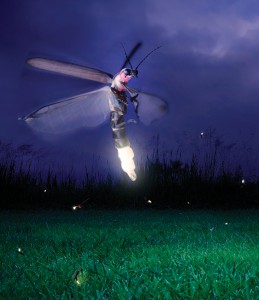Someday, consumers may be using lights that won’t show up on the monthly “light bill” or electric bill. The lights, which could replace fluorescent and be much more efficient than LED lamps, will glow using the science found in fireflies.
Scientists at Syracuse University have made what they are calling a transformational advance in an alternate light source — combining the natural light produced by fireflies with nanotechnology.
“Firefly light is one of nature’s best examples of bioluminescence,” said Mathew Maye, Syracuse University assistant professor of chemistry. “The light is extremely bright and efficient. We’ve found a new way to harness biology for nonbiological applications.”
Fireflies produce light through a chemical reaction between luciferin and its counterpart, the enzyme luciferase. In Maye’s laboratory, the enzyme is attached to a nanorod’s surface; luciferin, which is added later, serves as the fuel. The energy that is released when the fuel and the enzyme interact is transferred to the nanorods, causing them to glow.
Nanorods are microscopic objects made of the same materials used in computer chips, solar panels and LED lights. Maye said, “It’s conceivable that someday firefly-coated nanorods could be inserted into LED-type lights that you don’t have to plug in.”
Source: Syracuse University
Be sure to check out these related stories:
- Carrying a Torch: Students continue credible quest to have firefly named state insect
- When it comes to an insect, Indiana draws a ‘blaaaaaaank’
- Proposed insect named for famed New Harmony naturalist
- Oh, Say, can you see if it’s a Say’s Firefly?
- This firefly shines light on safety
- Waxing poetic in the firefly’s glow
- Create your own mascot; maybe win a plush Louie the Lightning Bug!
Be sure to check out these websites for more information about fireflies:




